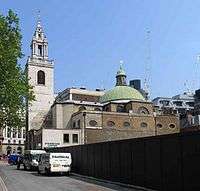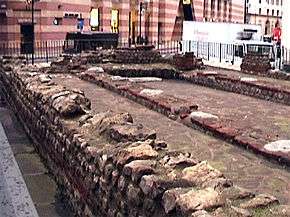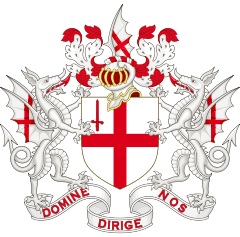Walbrook
| Ward of Walbrook | |
 Ward of Walbrook |
|
| OS grid reference | TQ325810 |
|---|---|
| Sui generis | City of London |
| Administrative area | Greater London |
| Region | London |
| Country | England |
| Sovereign state | United Kingdom |
| Post town | LONDON |
| Postcode district | EC4 |
| Dialling code | 020 |
| Police | City of London |
| Fire | London |
| Ambulance | London |
| EU Parliament | London |
| UK Parliament | Cities of London and Westminster |
| London Assembly | City and East |
Coordinates: 51°30′45″N 0°05′24″W / 51.51240°N 0.09°W
Walbrook is a subterranean river in the City of London that gave its name to a City ward and a minor street in its vicinity.
The ward of Walbrook contains two of the City's most notable landmarks: the Bank of England and Mansion House. The street runs between Cannon Street and Bank junction, though vehicular traffic can only access it via Bucklersbury, a nearby side-road off Queen Victoria Street.
The river
The brook played a very important role in the Roman settlement of Londinium, the city now known as London. The stream started in what is now Finsbury and flowed through the centre of the walled city, bringing a supply of fresh water whilst carrying waste away to the River Thames. Effectively dividing the settlement in two, it emerged just to the west of the present-day Cannon Street Railway Bridge. During Roman times it was also used for transport, with the limit of navigation some 200m from the Thames, at a point now known as Bucklersbury building. It was there the Romans built a port and temple to Mithras on the east bank of the stream.[1] The temple was found and later excavated during rebuilding work after World War II. The Roman Governor's palace was found further down the east bank of the stream, near its entry into the Thames. The etymology begins soon after Londinium was captured by the invading Anglo-Saxons during the late 6th century (also known then as Caer Lundein). It is thought that the brook was named because it ran through or under the London Wall; another theory is the name comes from Weala broc meaning 'brook of the Welsh'.[2] Walbrook formed one division in the city: Ludgate Hill to the west and Cornhill to the east.[3]
When St. Margaret Lothbury was rebuilt in 1440, the Lord Mayor Robert Large paid for the lower Walbrook to be covered over. By the time of the first maps of the area, the "copperplate" map of the 1550s and the derivative "Woodcut" map of c.1561, the whole Walbrook within the city walls was culverted. John Stow, the historian of London, wrote about the Walbrook in 1598, saying that the watercourse, having several bridges, was afterwards vaulted over with brick and paved level with the streets and lanes where it passed and that houses had been built so that the stream was hidden as it is now.[3]
The Walbrook's source was Moorfields, north of the City wall which it passed through just west of All Hallows-on-the-Wall Church.[4]


In the 1860s, excavations by General Augustus Pitt Rivers uncovered a large number of human skulls, and almost no other bones, in the bed of the Walbrook.[5] This has been seen as reminiscent of a passage from Geoffrey of Monmouth's History of the Kings of Britain (ca. 1136) in which a legion of Roman soldiers who surrendered to Asclepiodotus after being besieged in London were decapitated by his allies the Venedoti, and their heads thrown into a river called the Gallobroc.[6] However, Geoffrey's History is notoriously unreliable, and some historians consider these skulls to be a result of the rebellion of Boudica.[7] As late as the early 19th century, part of the branch that runs from Islington was open and powered a lead mill.[1]
The construction of the massive infrastructure of the London sewerage system with five main sewers incorporated many existing culverts, storm sewers, or sluices. This included the culvertized Walbrook, which by 1860 had been linked into a network of 82 miles worth of new sewerage lines, channeled to the Northern Low Level Sewer at a point near the Bank of England. Many small leaks stream into the rounded sewer for much of the year when the water table is sufficient.[8]
On 18 June 1999, during the "Carnival Against Capitalism", timed to coincide with the 25th G8 summit, fire hydrants were opened along the route of the Walbrook by Reclaim the Streets, symbolically releasing the river to "reclaim the street" from the "capitalist forces" of city growth which had subsumed it.[9]
The Walbrook is one of many "lost" rivers of London, the most famous of which is the River Fleet. It entered the Thames at Dowgate.
The ward


The river's only evidence above ground is the lower-end street called Walbrook, running parallel and a barely discernible dip in the land forming its catchment.[10] On the street is a church called St Stephen Walbrook, which originally stood on the west bank of the stream, but was rebuilt around 1439 on the east side. In 1666 the church was destroyed in the Great Fire of London and Sir Christopher Wren built a new church there in 1672 to replace it, which still stands. The historic London Stone is situated on Cannon Street within the ward of Walbrook. The Bank of England and Mansion House, the official residence of the Lord Mayor, are both situated in Walbrook ward. Within the ward is also The Walbrook Club, a private dining club founded in 2000. It was designed by the late Mark Birley of Annabel's and is set in a Queen Anne-style townhouse.[11]
Walbrook is one of 25 wards in the City of London, each electing an Alderman, to the Court of Aldermen and Commoners (the City equivalent of a Councillor) to the Court of Common Council of the City of London Corporation. Only electors who are Freemen of the City of London are eligible to stand.
See also
- Roman sites in the United Kingdom
- Tributaries of the River Thames
- Subterranean rivers of London
- List of rivers in England
References
- 1 2 Trench, Richard; Hillman Ellis (1985). London under London a subterranean guide. John Murray (publishers) Ltd. pp. 27–29. ISBN 0-7195-4080-1.
- ↑ Ackroyd, Peter (2000), London The Biography, ISBN 1-85619-716-6
- 1 2 London Archaeologist Spring 2003
- ↑ Barton, Nicholas (1962), The Lost Rivers of London.
- ↑ Lewis Thorpe, The History of the Kings of Britain, Penguin, 1966, p. 19
- ↑ Geoffrey of Monmouth, Historia Regum Britanniae 5.4
- ↑ John Morris (1982), Londinium: London in the Roman Empire p. 111.
- ↑ Walbrook River from London's Lost Rivers website
- ↑ Tyler, Wat (2003). "Dancing at the Edge of Chaos: a Spanner in the Works of Global Capitalism". In Notes From Nowhere. We Are Everywhere: the Irresistible Rise of Global Anticapitalism. London: Verso. pp. 188–95. ISBN 1-85984-447-2.
- ↑ Grid reference Finder measurement tools
- ↑ Rankine, Kate (2003-09-13). "Business profile: Chairman with a passion for needlework". The Daily Telegraph. Retrieved 2012-02-29.
London The Biography by Peter Ackroyd page 33
External links
- City of London Corporation Map of Walbrook ward (2003 —)
- Walbrook Ward The Official Ward Website
- An indepth resource for the history, issues and future proposals of how to deal with Londons Walbrook River and water issues in the city
- Map showing the location of the street named Walbrook
- Map showing the location of remains the temple of Mithras
- Map of Early Modern London: Walbrook Ward - Historical Map and Encyclopedia of Shakespeare's London (Scholarly)
- Walbrook Discovery Programme
| Next confluence upstream | River Thames | Next confluence downstream |
| River Fleet (north) | Walbrook | River Neckinger (south) |
